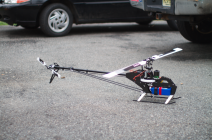Great work on the project, I know how many hours you must have put into this! I've been involved with a team at my Uni which had to find targets on the ground using remote controlled aircraft as autonomously as possible, so I've got a bit of knowledge in the area.
I don't know how much knowledge you have in the area (you might already know much of what I'm about to say) but here's some of my own insight for you.
Rubber bands aren't good to use alone, or at all. You primarily need damping as well as springs (mass-spring-damper systems). The pool noodle should have some damping, but try checking out some other materials. One thing I've seen mentioned is a type of gel from McMaster-Carr (see
forums discussion and McMaster-Carr item
Ultra-Elastic Clear Rubber Gel). Try your best to isolate the vibrations from the rotor hub and the camera (anywhere between the two).
For seeing the video on the ground, there are video transmitters you can get fairly cheap (some better than others). It's generally all grouped under the term FPV. Transmission power and antenna gain (dB rating) will determine your range. Note that the higher the dB, the more directional the antenna signal (for send and receive). This can result in you needing to have a high-gain antenna on the ground follow the aircraft. The GoPro has a video out that can send SD video to a video transmitter. Video goggles can be used to fly the aircraft or control the camera from the camera's point of view.
Pan-tilt systems are often used to control the camera on-board the aircraft. They are very basic, but can give you some degree of control. You can have them be auto-stabilized if you have an IMU on board the aircraft, or another form of orientation sensor (thermopiles, etc). See
this photo for the one I used recently at a competition. It will be difficult to get smooth motion using standard servo motors.
Here's a video of some of the footage taken from the same flying wing aircraft without a pan-tilt installed, but still using a GoPro with the 720p FOV. It didn't have anything special used to dampen the vibrations -- just the foam aircraft body. Your best bet for stabilization, as mentioned above, is stabilizing gyros. These are different than the MEMS (electronic) gyros used for instrumentation -- they would be mechanical gyros. I've also heard of using water levels on board some larger RC aircraft. I don't know the details, but you can ponder the thought if you are interested.
If you want to try something a little different with the GoPro before upgrading cameras, you can check out the Sunex lens mod. It will get rid of most of the fisheye, but tends to be a little soft around the edges. I've found the diagonal FOV to be around 80-60 deg (depending on 720p or 1080p). It might be a little too great a focal length. Ragecams has some other lens, but I've heard that their optical quality is worse.
For your custom aircraft design, be sure to start with the payload (camera). Get your stabilization system worked out, then plan on designing the aircraft around that. Doing it the other way around will compromise your footage. I'm likely going to have to do a compromise with a current custom aircraft, and it won't be fun to say the least. (This aircraft modified to have a stabilized downwards-facing Canon Rebel DSLR or point and shoot controlled using custom firmware and an on-board computer). My purposes are of course a little different than yours.
Good luck, and I look forward to seeing what you put out with your system. If you have any questions, feel free to shoot me a PM and I'll do my best to help.

